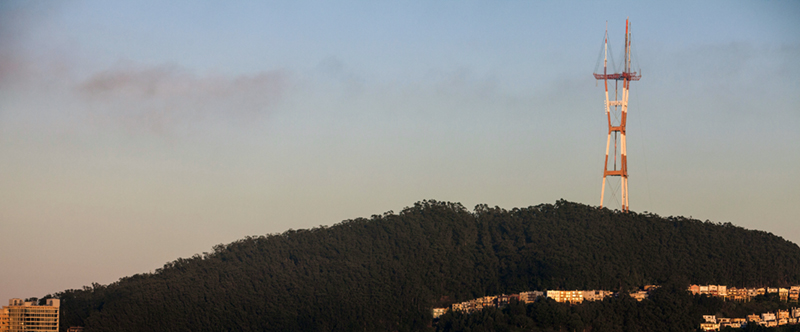Two years ago, the FCC, with interested parties in Microsoft, Google, and many startups, created the Citizens Band Radio Service (CBRS), a rule that would open up the 3550-3650 MHz band to anyone, or any company, to create their own wireless backbone between WiFi access points. It is the wireless solution to the last-mile problem, and last year the FCC enthusiastically endorsed the creation of the CBRS.
In a recently released FCC filing, Google has announced their experimental protocol for testing the new CBRS. This isn’t fast Internet to a lamp pole on the corner of the street yet, but it lays the groundwork for how the CBRS will function, and how well it will perform.
Google will be testing the propagation and interference of transmissions in the 3.5 GHz band in places around the US. Most of the Bay Area will be covered in the tests, as well as Boulder, CO, Kansas City, Omaha, Raleigh, NC, Provo, UT, and Reston, VA. Tests will consist of a simple CW tone broadcast in the 3.5 GHz band.
The 3.5 GHz band is already allocated to shipborne navigation and military radar systems, posing an obvious problem to any wireless broadband system using this spectrum. To this end, the FCC is proposing a novel solution to the problem of coexistence between the CBRS and the military. Instead of simply banning transmissions in the spectrum, FCC Chairman Wheeler proposes, “computer systems can act like spectrum traffic cops.” A computer is able to direct the wireless traffic much more effectively than a blanket ban, and will allow better utilization of limited spectrum.
Google’s FCC filing is just for testing propagation and interference, and we have yet to hear anything about how a network built on 3.5 GHz spectrum will be laid out. One thing is for certain, though: you will not have a 3.5 GHz USB networking dongle for the same reason you don’t have a Google Fiber input on your desktop.
















But I *do* have a Google Fiber input, or close enough: I have a NIC with an SFP slot. Just give me a GPON SFP and I’m good to go.
I think the only barriers will be in paperwork, getting google to give you access, assuming you can come up with the RX/TX equipment and an implementation of the protocols. (kind of like showing up to you ISP with your own modem)
Hopefully Google and the FCC will have a similar opinion.
3550-3650 MHz? Isn’t that part of the ham allocation? I almost dies when I read that :-)
Duh! I’m confusing my KHz’s with my MHz’s :-)
all the speeds of dial up with the convenience of wireless!
does this mean my future as a code bum is secure?
No, we have 3.3 Ghz to 3.5 Ghz. Ubiquiti actually made some gear you could use on those frequencies. Unfortunately it seems the radios are extremely hard to find now.
I said this when they passed this law allowing the “HAM” bands to be used by other devices. This is going to totally mess up NON-Government controlled communications. It will jam the “Ham” bands with so much noise they would be useless for communication.
So is the idea that this covers up to the last mile and there’d still be a cable coming on prem, or that there’d be a box similar to my FIOS ONT located in my basement?
From reviewing the FCC docs it sounds like this is going to just be straight LTE, since they reference deploying eNodeBs (part of a standard LTE network).
There’s also a Spectrum Access System they are working on (source: http://www.its.bldrdoc.gov/media/66165/marshall.pdf) to manage frequency coordination on CBRS for these devices.
Normally it will be technology neutral. Due to LTEs prevalence many people now refer to a base station as ‘eNodeB’. I have even read the term eNodeB being used in a (non-technical) presentation about WiMax, refering to the WiMax base stations (ASNs, IIRC)
I think this is more likely LTE if only because of the SAS presentation link — eg, slide 4: “Integrated SAS with LTE NMS/EPC…”
Typically “Last Mile” means that they will have a high speed connection (such as fiber) going to your neighborhood. But instead of running one line to each house they will beam the signal wirelessly. This means you will likely have an antenna on top of your house instead of a box in your basement. Last mile connections are a big deal to service providers because it represents a huge portion of infrastructure costs.
I wonder if Google does QSL for reception reports of the 3.5GHz CW tone.
A C-band PLL LNB + RTL-SDR should be all it takes to receive it in the coverage areas.
I am a little out of numbers. On the link provided, FCC document says, in the title section: ‘Operations in the 3550-3650 MHz Band’ and in the description section: ‘Rules To Make Up To 150 Megahertz Of Spectrum’
No matter how many times I try, I get it as 100 Mhz ( ;) I even tried using a calculator. :) )
The band is from 3550-3700.
Train wreck about to happen.
End result when you have more lawyers running a federal agency than qualified RF/Electrical engineers. Ironic that the name
“Citizens Band….” was chosen. Flashback to the chaos in the 1970’s and the gradual unusable wasteland 11 meters became. A telling harbinger of the future. Not unlike the FCC allowing Nextel to takeover the private SMR’s on 800 mhz, and in the process totally obliterating public safety 800 trunked systems with RFI. Causing further headaches and “re-banding” to solve a problem that never should have existed in the first place.
Again, train wreck … wait for it … wait for it.
“computer systems can act like spectrum traffic cops.”
I guess more ways for big brother to listen in on us.